There are two spiritual dangers in not owning a farm. One is the danger of supposing that breakfast comes from the grocery, and the other that heat comes from the furnace. . . . To avoid the second, he should lay a split of good oak on the andirons, preferably where there is no furnace, and let it warm his shins while a February blizzard tosses the trees outside. If one has cut, split, hauled, and piled his own good oak, and let his mind work the while, he will remember much about where the heat comes from, and with a wealth of detail denied to those who spend the week end in town astride a radiator.
–Aldo Leopold (“February” in A Sand County Almanac)
Johnson County, TN. Those who prefer wood heat can give you a list of its advantages:
- Under the best circumstances wood is a local and renewable resource.
- Heating with wood can give a person a small measure of independence.
- Depending on the layout of your home, wood heat can be used to create multiple zones—sixty degrees in the bedrooms, eighty in the stove room—with gradients in between.
- Wood heat works when the power is out.
- Cutting and hauling wood is great exercise, and if you split it by hand like John Cuddeback and I do, even better.
As an apologist for heating with wood, I’ve uttered each of these points at one time or another. In other words, I am a believer in the utilitarian advantages of wood heat.
But there are philosophical dimensions (and some puzzles) to heating with wood as well. As Aldo Leopold remarks at the beginning of his “February” essay, heating with wood helps one avoid the “spiritual danger” of not knowing the real source of one’s heat—a sentiment our own Jeff Bilbro echoes in “Trees” when he says, “I want no illusions that heat is painless” (see Local Culture vol. 2 no. 1). In the balance of his essay, Leopold makes clear that cutting and splitting wood also has the positive effect of leading one to contemplate history and ecology. If you’ve read this far because you have some interest in firewood but haven’t read “February,” stop now and spend some time with Aldo. My focus here is on some other ways that heating with wood influences one’s thinking and, by extension, shapes one’s behavior.
First and foremost, heating with wood requires planning. Paradoxically, *well-seasoned* wood does not grow on trees. Best practices for heating with wood dictate that one had better budget for several months of curing and drying—a year is even better. And this is not an aspirational best practice given that burning unseasoned, “green” wood is frustrating, inefficient, and dangerous: unseasoned wood leads to greater creosote build-up in the flue and thus an increased risk of a flue fire.
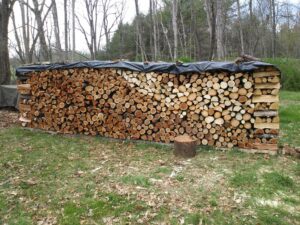
To have a year’s supply of firewood stacked and covered twelve months before one plans to burn it requires a commitment to preparation that runs counter to our “on demand” and “just-in-time” world. Sometimes those of us with such commitments find one another in unexpected places. The germ for this essay sprouted unexpectedly in the minutes leading up to a 2021 faculty meeting. Several of us sauntered in many minutes early. The talk turned to the weather: “this November has been cold, hasn’t it?” Someone confirmed that, yes indeed, he had burned far more wood this November than last November. Slowly an unknown common denominator emerged: nearly all of us at the meeting early (regardless of department or rank) heated with wood as either our primary source or as a way to augment another system. A coincidence? Probably. But I wondered to what degree heating with wood creates a habit of mind that keeps one on or ahead of schedule.
The habit of preparedness, at least when it comes to firewood, becomes deeply engrained if one runs out of (seasoned) firewood while the weather is still cold. That experience teaches a lesson that easily transfers to other situations. My grandfather had an expression that I have found very adaptable; my wife, having heard me adapt the expression perhaps too often, might say that it’s not as applicable as I think it is. She has pointed out that I am rather fond of the following formula: “I feel about ____________ as my grandfather felt about firewood: I would rather have it and not need it than need it and not have it.” Such a philosophy can be taken too far: we may not ever need the redundant, vintage microwave I am storing in the attic. But in general, to err on the side of caution and preparedness is one of my better habits of mind, and probably fostered by a childhood that included lessons in firewood.
In addition to the long-term planning required to ensure that an abundant supply of wood is cut, stacked, and covered months before it is needed, there are also a number of shorter-term concerns one must address during the months when one is keeping a fire. For example, I tend to pay more attention to weather forecasts during the winter, and not just for the possibility of a big snow. Bringing seasoned, dry wood into the house on a sunny day just before any kind or amount of precipitation sets in is inspiring work; so is taking the wood ash out to the garden or fruit trees. In both cases one can easily imagine future comfort and pleasure. Undertaking either of those tasks during inclement weather tends to be unpleasant. With just a little foresight (and more-or-less accurate forecasts) one can pretty well hunker down close to the stove on the chilly and wet days.
I also must arrange each day around feeding the stove, or feed my stove when the day’s itinerary allows. This aspect of heating with wood creates a layer of complexity that is absent from HVAC systems with a thermostat one can “set and forget.” Complexity is not automatically bad, though. Most days I like the rhythm my stove imposes; I find it satisfying to begin my days by building up the fire and setting it to its work before I begin mine. And it feels proper to me to end each day by seeing to the fire and setting it once again to its work—this time just before I take my rest. There is a fundamental simplicity to burning wood to heat a home—an essential need being met by one of the ancient elements—that abides just behind whatever complexities the task requires.
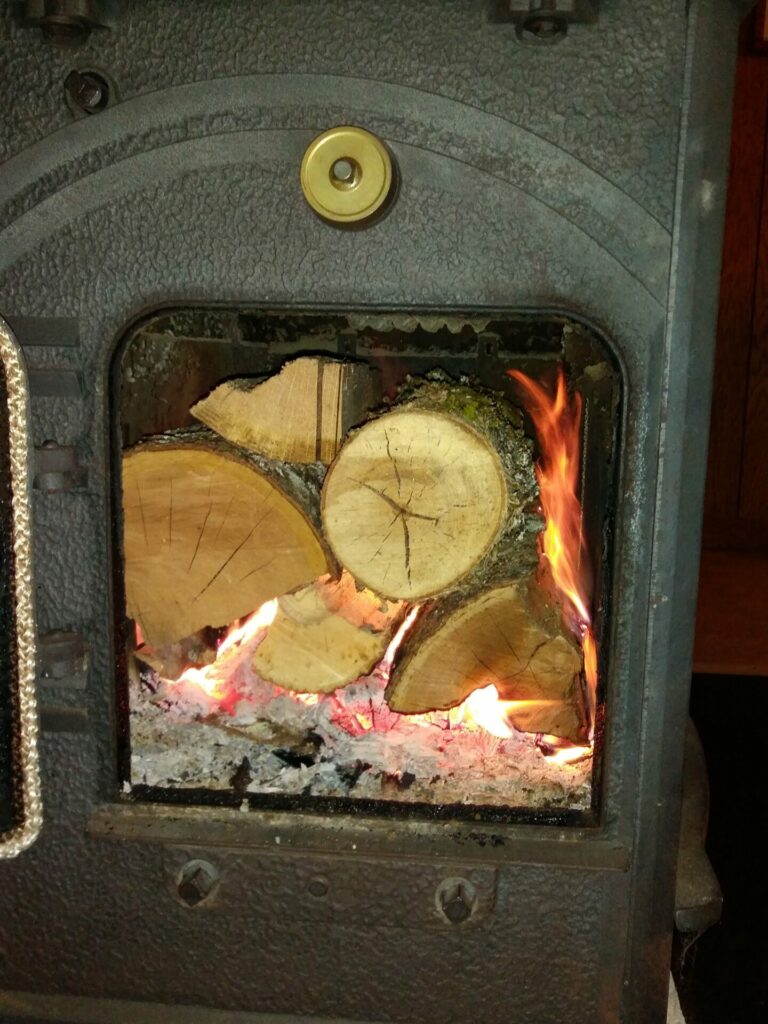
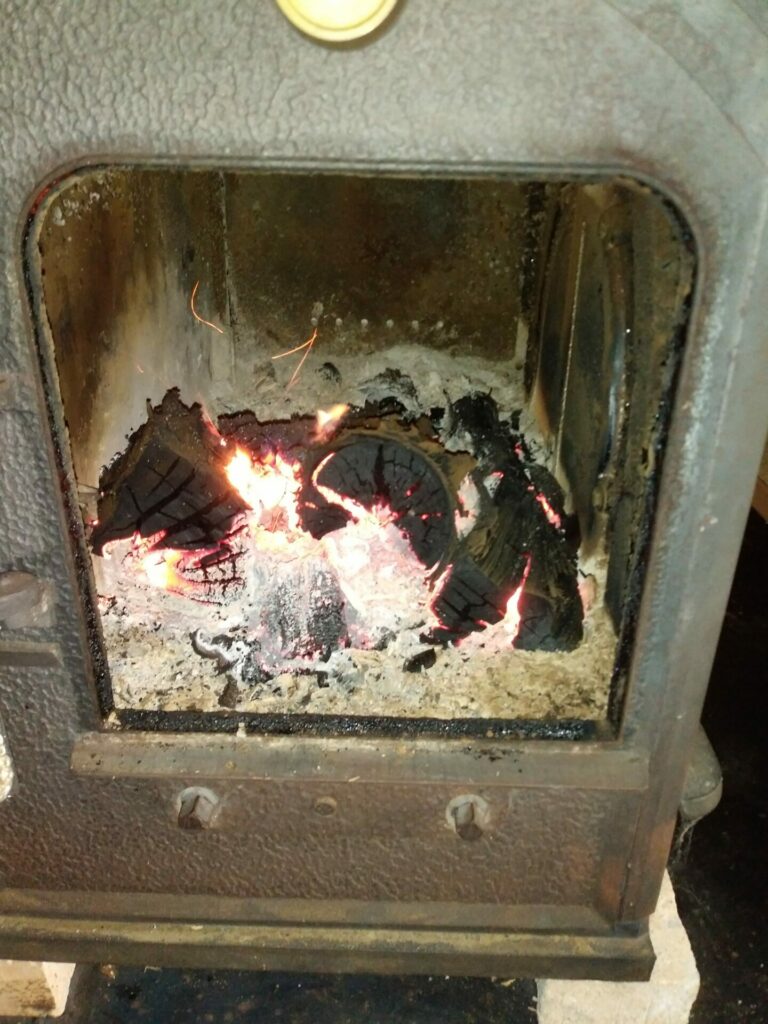
And the complexities of feeding a fire—the details of what?, when?, and how?—create excellent opportunities to grow one’s knowledge. Not all wood is created equal. I reach for different kinds of wood depending on several ever-shifting variables. If I need a hot, long-lasting fire, I reach for oak, hickory, or black locust (Robinia psuedoacacia). Mild days call for red maple (Acer rubrum), black cherry (Prunus serotina), or birch.
Thus, depending on wood for heat places one in a close relationship with wood. In addition to the BTUs particular species contain, one who is mindful and observant can learn much about other, sometimes subtle characteristics of specific species of trees for, as Thomas Hardy notes at the beginning of Under the Greenwood Tree (1872), “to dwellers in a wood almost every species of tree has its voice as well as its feature.” Black walnut (Juglans nigra), as it burns, buries itself in a layer of ashes that insulate and preserve coals. In this regard black walnut even seems to outlast long-burning, high-BTU species like oak, hickory, and locust. I don’t know exactly what to call this quality other than an afterlife. Black walnut seems to me to have the longest afterlife I have come across—even after the fire has dwindled and the stove cooled, I have uncovered a bed of glowing embers that enables me to bring the fire back to life. Tulip tree (Liriodendron tulipifera) is about the opposite: it ignites quickly and burns out rapidly. And it gets its other name (yellow poplar) from the way it “pops” as it burns, so be wary of leaving an open poplar fire unattended.
Heating with wood also extends one out into the community or one’s own property. I knew my mother’s fifty-acre woods intimately because I was always ranging over it on the lookout for firewood: standing dead trees, blow downs, or trees that had been overtopped and outcompeted by their peers. When I lived on two cleared acres in North Carolina, I checked the Craigslist free page and Facebook marketplace pretty often. I have not forgotten the “win-wins” orchestrated over such sites: by helping to solve what was a problem for someone else—a dead oak tree that the power company had felled and left in someone’s yard—I was addressing some of my own needs.
My own neighbors were probably less enthusiastic about my problem solving. I was liable to be out in the yard ka-booming on free firewood with a maul and steel wedges at any hour of the day. And my stove did not have any secondary combustion feature, so some of my fires were smoky and smelly; in short, I was polluting the neighborhood with noise and some harmful emissions.
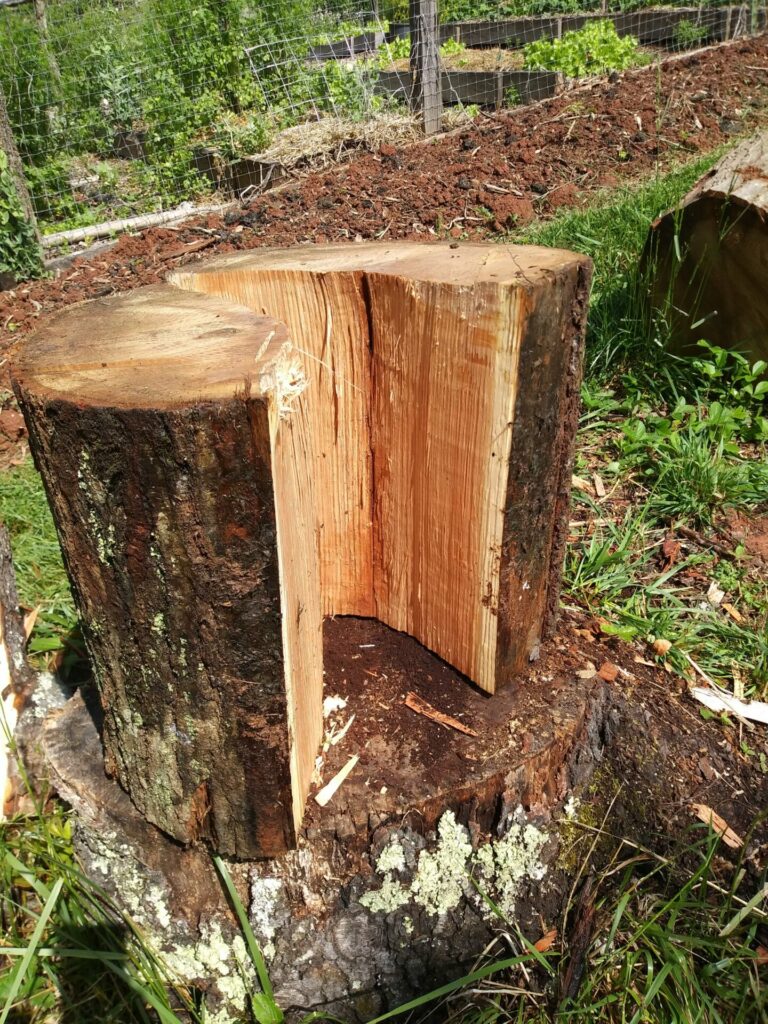
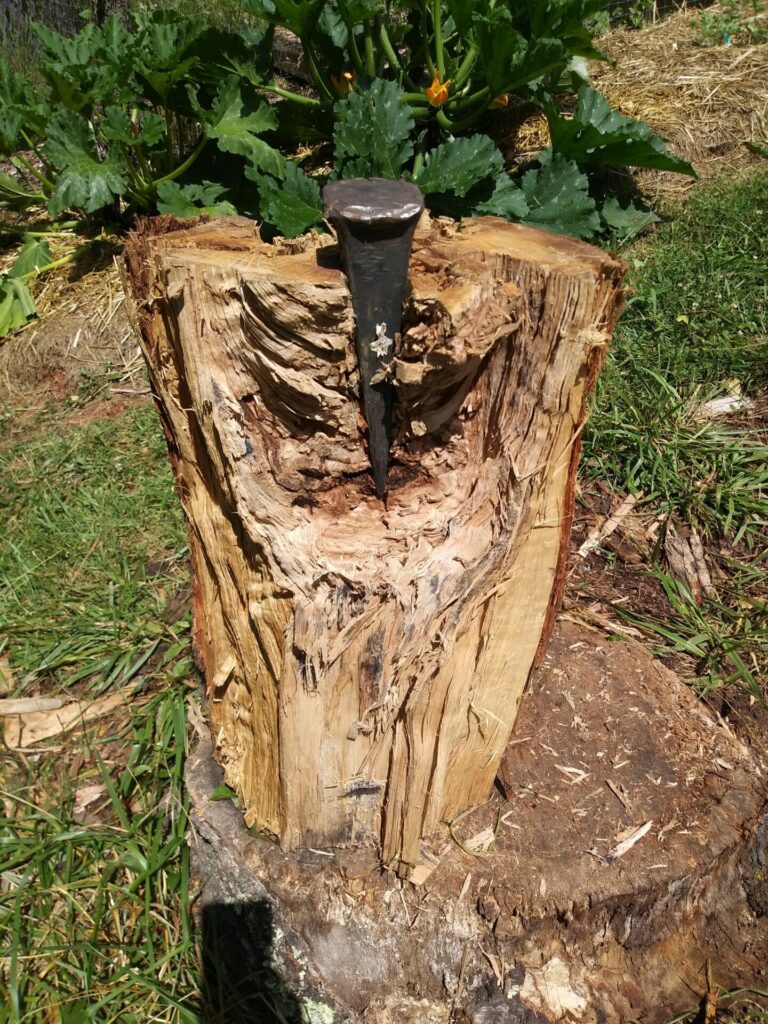
Now my wife and I live on twelve, mostly wood acres. We added a woodstove (I found it on Craigslist) that includes a catalytic combustor that burns up the smoke coming from my fire; “the result,” according to my manual, “is longer burns, more heat per pound of wood, and less creosote.”
And so I find myself once again roaming in woods and contemplating forest succession. I can imagine spending a lifetime shaping these woods by the decisions I make to stay warm. Mostly I will be helping movements that are already underway. About half of the “woods” are overgrown nursery stock plots. Thirty or forty years ago, someone set out white pine, hemlock, and spruce in the low-lying areas along an intermittent creek. My grandfather taught me that “white pine doesn’t like to have its feet wet,” and I can see that he was right. Few of those Pinus strobus are thriving. Nature is already at work on a correction: in a few places, black walnut, sycamore, and black cherry (species that do much better on what my silviculture professor called “hydric sites”) have kept pace with the pines and claimed a piece of the canopy. I am seeing only a snapshot of what is already a long story (by human standards), but it looks to me like the walnuts and cherries are starting to outcompete and crowd out the dwindling white pines and the slower growing hemlocks. In time, the offspring of those hardwood trees (along with maple) will likely reclaim all of the wet ground. With a little help from me, it might happen slightly more quickly.
I am already speeding along the regeneration of young yellow poplars along the bases of some slopes and shelves where rain has worked for centuries to heap and pile some rich, alluvial soil. The poplars seeded in too thickly, and now they are competing against one another for nutrients, sunlight, and water. While I trim out the damaged ones and those with poor form, I cannot stop myself from imagining what the trees I leave might one day become. In another century or two, some of these young trees might be a hundred feet tall and two or three feet in diameter. If enough of those kinds of trees close their ranks at the canopy, they create what I’ve heard called a “poplar cathedral.” Such forests, Joyce Kilmer Memorial Forest in North Carolina is one, are well named because they are indeed imbued with a kind of magical divinity.
On rockier ground, I look for young oaks and hickories that I can leave in place to succeed the older trees. Oaks and hickories will thrive on ground where one would need dynamite to dig a post hole and some of the young ones here will make mast and capture carbon for all of my life before they enter their own middle age.
Along with the hyper-local decisions about which trees to cut and which to leave, heating with wood also leads me to ponder my place in “the global carbon economy.” The accounting is beyond my abilities, but I’d like to think my firewooding practices (like Aaron Weinacht, I rely on a chainsaw with a two-cycle engine and a truck manufactured in the eighties—mine is an ’84 Ford F150 that goes by “O.D.” because shortly after we joined forces the “F” and the “R” fell off the tailgate) generate a smaller footprint than would my other options for heating my home. Wood is stored solar energy. So surely I require a smaller quantity of fossil fuels to cut and haul my wood than would be required to manufacture, transport, and install the solar panels, batteries, and inverters necessary to power my heat pump. Of course it’s more complicated than that; as I said, the accounting is beyond my abilities. Which leaves me pretty close to where I began: I enjoy certain utilitarian advantages by heating with wood, but I also prefer the habits of mind—attention, connection, succession, frugality—that my woodpile’s growth and contraction inspires.
Images by Author.

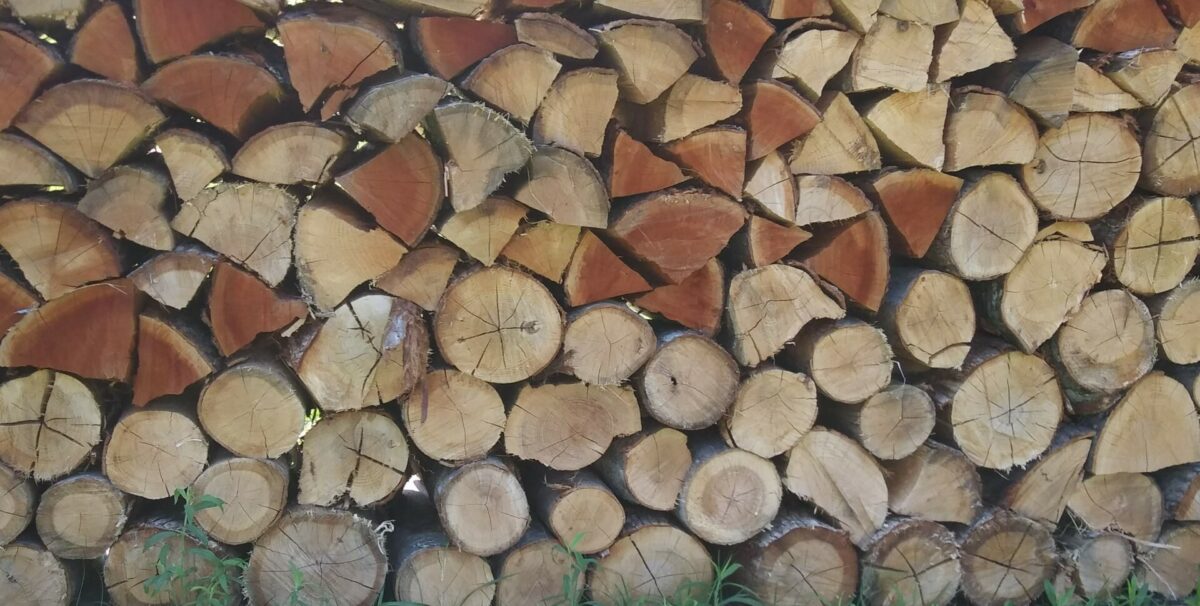

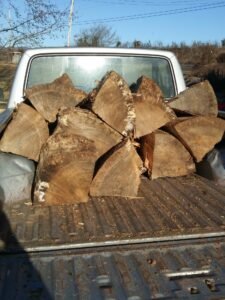


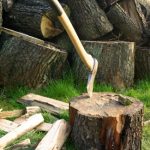
6 comments
Phil
Thanks Professor, excellent essay. I’m not sure why we enjoy heating with wood so much, but we sure do.
You are right that carbon accounting is very complicated. Like us, it appears you are burning dead wood, in other words wood that would otherwise decompose and release the same amount of CO2 as when you burn it. If that is the case, the carbon accounting is simple and clear – you are contributing essentially zero CO2 to the atmosphere, yet you are heating your house. Continue to run your woodstove guilt free.
Aaron
The commenter above you also appears not to know about catalytic and other re-burning technology in wood stoves. When you run my stove correctly, I can burn from October to April without ever shoveling it out. Perhaps the previous commenter was just trolling.
Thomas McCullough
I have neither the experience nor inclination to deny anything written here. I do point out, though, that burning firewood is VERY polluting of the air.
Amanda Patchin
Very nice. I appreciate this, although my species familiarity is distinctly different. I grew up cutting, splitting, stacking, and burning pine, fir, and — rarely — birch in Northern Idaho. Softwoods and a leaky log cabin meant we were regularly putting up 15 to 20 cords a year.
Have you read Norwegian Wood? Not the Murakami novel but Lars Mytting’s lovely exploration of his native land’s art of firewood? It is delightful and I think you will enjoy it!
Ethan Mannon
Thanks for the recommendation, Amanda. I’m not familiar with Mytting’s text, so I will definitely track it down. . . . 15-20 cords per year is hard for me to imagine!
Brian D Miller
What a lovely essay, Ethan. It reminds me to make sure to start work, belatedly, on my 23-24 stash, because “I feel about ____________ as my grandfather felt about firewood: I would rather have it and not need it than need it and not have it.”
And that is also a fair amount of skill you exhibit in your wood stacking. Mine, even with more than a few years of practice, elicits only scorn and concerns about this stacker’s interior moral life.
Comments are closed.